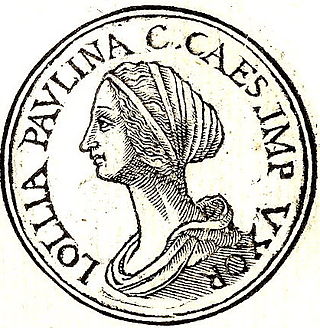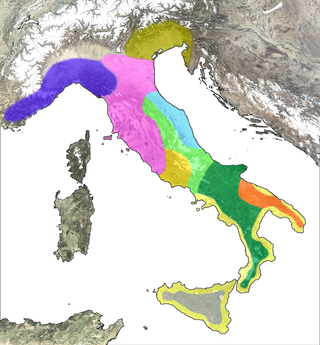Related Research Articles

Anicius Olybrius was Roman emperor from July 472 until his death later that same year; his rule as Augustus in the western Roman Empire was not recognised as legitimate by the ruling Augustus in the eastern Roman Empire, Leo I. He was in reality a puppet ruler raised to power by Ricimer, the magister militum of Germanic descent, and was mainly interested in religion, while the actual power was held by Ricimer and his nephew Gundobad.

The gens Fabia was one of the most ancient patrician families at ancient Rome. The gens played a prominent part in history soon after the establishment of the Republic, and three brothers were invested with seven successive consulships, from 485 to 479 BC, thereby cementing the high repute of the family. Overall, the Fabii received 45 consulships during the Republic. The house derived its greatest lustre from the patriotic courage and tragic fate of the 306 Fabii in the Battle of the Cremera, 477 BC. But the Fabii were not distinguished as warriors alone; several members of the gens were also important in the history of Roman literature and the arts.

The gens Mamilia was a plebeian family at ancient Rome during the period of the Republic. The gens was originally one of the most distinguished families of Tusculum, and indeed in the whole of Latium. It is first mentioned in the time of the Tarquins; and it was to a member of this family, Octavius Mamilius, that Lucius Tarquinius Superbus, the seventh and last King of Rome, betrothed his daughter. The gens obtained Roman citizenship in the 5th century BC, and some of its members must subsequently have settled at Rome, where Lucius Mamilius Vitulus became the first of the family to hold the consulship in 265 BC, the year before the First Punic War.

Quintus Curtius Rufus was a Roman historian, probably of the 1st century, author of his only known and only surviving work, Historiae Alexandri Magni, "Histories of Alexander the Great", or more fully Historiarum Alexandri Magni Macedonis Libri Qui Supersunt, "All the Books That Survive of the Histories of Alexander the Great of Macedon." Much of it is missing. Apart from his name on the manuscripts, nothing else certain is known of him. This fact alone has led philologists to believe that he had another historical identity, to which, due to the accidents of time, the link has been broken. A few theories exist. They are treated with varying degrees of credibility by various authors. Meanwhile, the identity of Quintus Curtius Rufus, historian, is maintained separately.

Lollia Paulina, also known as Lollia Paullina was a Roman empress for six months in 38 as the third wife and consort of the Roman emperor Caligula.
Rugila or Ruga, was a ruler who was a major factor in the Huns' early victories over the Roman Empire. He served as an important forerunner with his brother Octar, with whom he initially ruled in dual kingship, possibly a geographical division where Rugila ruled over Eastern Huns while Octar over Western Huns, during the 5th century AD.

The Umbri were an Italic people of ancient Italy. A region called Umbria still exists and is now occupied by Italian speakers. It is somewhat smaller than the ancient Umbria.

Aëtius of Amida was a Byzantine Greek physician and medical writer, particularly distinguished by the extent of his erudition. His birth and death years are not known, but his writings appear to date from the end of the 5th century or the beginning of the 6th.

The gens Quinctia, sometimes written Quintia, was a patrician family at ancient Rome. Throughout the history of the Republic, its members often held the highest offices of the state, and it produced some men of importance even during the imperial period. For the first forty years after the expulsion of the kings the Quinctii are not mentioned, and the first of the gens who obtained the consulship was Titus Quinctius Capitolinus Barbatus in 471 BC; but from that year their name constantly appears in the Fasti consulares.

Kydonia or Cydonia was an ancient city-state on the northwest coast of the island of Crete. It is at the site of the modern-day Greek city of Chania. In legend Cydonia was founded by King Cydon (Κύδων), a son of Hermes or Apollo and of Akakallis, the daughter of King Minos. According to Pausanias he was son of king Tegeates.
Serapion of Alexandria was a physician who lived in the 3rd century BC. He belonged to the Empiric school, and so much extended and improved the system of Philinus of Cos, that the creation of the school is attributed to him by some ancient writers. Serapion wrote against Hippocrates with much vehemence, but neither this, nor any of his other works, have survived. He is several times mentioned by Celsus, Galen, Caelius Aurelianus, Aëtius, Paulus Aegineta, and Nicolaus Myrepsus.
The gens Servilia was a patrician family at ancient Rome. The gens was celebrated during the early ages of the Republic, and the names of few gentes appear more frequently at this period in the consular Fasti. It continued to produce men of influence in the state down to the latest times of the Republic, and even in the imperial period. The first member of the gens who obtained the consulship was Publius Servilius Priscus Structus in 495 BC, and the last of the name who appears in the consular Fasti is Quintus Servilius Silanus, in AD 189, thus occupying a prominent position in the Roman state for nearly seven hundred years.

The gens Considia was a plebeian family at ancient Rome. The Considii came to prominence in the last century of the Republic, and under the early Empire, but none of them rose any higher than the praetorship.
The gens Fufia was a plebeian family at ancient Rome. The gens does not appear to have been of great antiquity, and only appears in history toward the beginning of the first century BC.
The gens Gallia was a plebeian family at ancient Rome. Several members of this gens are mentioned during the first century BC.
The gens Lavinia was a minor family at ancient Rome.

The gens Opimia, also written Opeimia on coins, was a plebeian family at ancient Rome. Members of this gens are first mentioned during the time of the Samnite Wars, and they are mentioned in Roman historians from then down to the end of the Republic. The first of the Opimii to obtain the consulship was Quintus Opimius in 154 BC.
The gens Paccia, occasionally written Pactia, was a minor plebeian family at ancient Rome. Only a few members of this gens achieved distinction in the Roman state, of whom the most illustrious was Gaius Paccius Africanus, consul in AD 67.
The gens Iteia or Itia was an obscure plebeian family at ancient Rome. No members of this gens are mentioned by ancient writers, but several are known from inscriptions. Perhaps the most illustrious of the family was Iteius Rufus, legate of Thracia during the reign of Hadrian.

The Tomb of the Haterii is an Ancient Roman funerary monument, constructed between c. 100 and c. 120 CE along the Via Labicana to the south-east of Rome. It was discovered in 1848 and is particularly noted for the numerous artworks, particularly reliefs, found within.